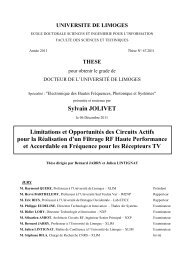Contribution à la conception optimale en terme de linéarité et ...
Contribution à la conception optimale en terme de linéarité et ...
Contribution à la conception optimale en terme de linéarité et ...
Create successful ePaper yourself
Turn your PDF publications into a flip-book with our unique Google optimized e-Paper software.
CHAPITRE II – CONSIDERATIONS GENERALES SUR LA LINEARITE DES AMPLIFICATEURS DE PUISSANCE<br />
II.5.2.2.2. - Métho<strong>de</strong> du trou<br />
Dans <strong>la</strong> métho<strong>de</strong> du trou, on choisit une répartition équidistante <strong>de</strong>s porteuses. Les<br />
produits d’intermodu<strong>la</strong>tion r<strong>et</strong>omb<strong>en</strong>t donc forcém<strong>en</strong>t sur <strong>de</strong>s porteuses. Afin <strong>de</strong> détecter une<br />
partie <strong>de</strong>s produits d’intermodu<strong>la</strong>tion, on réalise au préa<strong>la</strong>ble un trou étroit au c<strong>en</strong>tre <strong>de</strong> <strong>la</strong><br />
ban<strong>de</strong> du signal (Figure II.13).<br />
0<br />
2f2-f3=f2-Δf<br />
Δf Δf<br />
f 1 f 2 f 3 fréqu<strong>en</strong>ce<br />
2f2–f1=f2+Δf<br />
Quand ce signal est injecté dans un amplificateur, les produits d’intermodu<strong>la</strong>tion<br />
générés par <strong>la</strong> non-<strong>linéarité</strong> rempliss<strong>en</strong>t le trou c<strong>en</strong>tral. Ce trou est généralem<strong>en</strong>t connu sous<br />
son vocable ang<strong>la</strong>is « NOTCH »<br />
Signal d’<strong>en</strong>trée Signal <strong>de</strong> sortie<br />
Fréqu<strong>en</strong>ce<br />
NL<br />
Fréqu<strong>en</strong>ce<br />
Figure II.13 – Spectres <strong>de</strong>s signaux d’<strong>en</strong>trée <strong>et</strong> <strong>de</strong> sortie d’un amplificateur<br />
La puissance moy<strong>en</strong>ne du bruit est déterminée <strong>en</strong> faisant <strong>la</strong> moy<strong>en</strong>ne <strong>de</strong>s puissances<br />
<strong>de</strong>s raies dans le trou (Figure II.14)<br />
Pbruit<br />
=<br />
p<br />
1<br />
∑ bi<br />
P<br />
i=<br />
1<br />
La puissance moy<strong>en</strong>ne <strong>de</strong>s porteuses est estimée <strong>en</strong> évaluant <strong>la</strong> moy<strong>en</strong>ne <strong>de</strong>s<br />
puissances <strong>de</strong>s porteuses <strong>et</strong> <strong>en</strong> r<strong>et</strong>ranchant <strong>la</strong> puissance du bruit obt<strong>en</strong>ue précé<strong>de</strong>mm<strong>en</strong>t<br />
(figure) afin <strong>de</strong> t<strong>en</strong>ir compte <strong>de</strong> l’apport <strong>de</strong>s produits d’intermodu<strong>la</strong>tion sur les porteuses.<br />
63<br />
(7)
















